Arc Characteristics and Welding Process of Laser K-TIG Hybrid Welding
Abstract
:1. Introduction
2. Experimental System and Procedure
2.1. Experimental System
2.2. Laser K-TIG Hybrid Welding Process Parameters
3. Results and Discussions
3.1. The Effect of K-TIG Welding Current on the Laser K-TIG Arc Profile
3.2. The Effect of K-TIG Welding Current on the Welded Depth and Width
3.3. The Effect of the Distance between Heat Sources on the Weld Formation
3.4. The Effect of the Laser Power on the Welded Depth and Width
3.5. The Effect of the Laser Defocusing and Welding Speed on the Welded Depth and Width
4. Variation in Microstructure and Mechanical Properties
4.1. Microstructure
4.2. Hardness Profile and Tensile Test
5. Conclusions
- (1)
- A laser K-TIG hybrid welding test system has been successfully built, and through this system, the parameters of hybrid welding such as laser power P, welding current I, laser defocusing amount f, welding speed V, and heat source distance D can be adjusted. Stable, flat-plate-butt experiments were carried out on Q235 carbon steel.
- (2)
- The addition of laser makes K-TIG arc offset, and as K-TIG arc current increases, the offset becomes smaller. If K-TIG arc current and laser power are too large, a large amount of photoinduced plasma is generated to shield laser energy and the welded depth decreases. Different heat source distances and laser defocusing amounts will cause the laser beam to act at different positions. When the laser acts on the bottom of K-TIG keyhole, the welded depth can be further increased. Due to the coupling effect between the heat source and the large K-TIG current, a high welding speed should be maintained during laser K-TIG hybrid welding process to prevent the heat input from being too large and the molten pool from collapsing.
- (3)
- The microstructure analysis and microhardness test of typical welded of laser K-TIG hybrid welding show that the welded morphology is a nail shape with a wide upper part and a narrow lower part. The crystalline direction of the weld seam is perpendicular to the fusion line and points to the center line of weld seam. The grains in the action zone (upper part) are coarser than those in the laser action zone (lower part), and the fusion zone shows, more columnar crystals. In addition, the heat affected zone in the laser action zone is small, and almost no change in the structure near the weld can be seen.
- (4)
- The tensile test found that the fractures were all located at the base metal position. In order to measure the actual mechanical properties of weld, the samples were reworked, and the influence of hybrid welding process parameters on the tensile strength was studied. The weld strength first increases and then decreases with the increase of K-TIG arc current I, heat source distance D, and welding speed V, respectively. The weld strength first decreased and then increased with the increase of laser power P, and it showed a downward trend with the increase of defocusing amount f.
Author Contributions
Funding
Institutional Review Board Statement
Informed Consent Statement
Data Availability Statement
Acknowledgments
Conflicts of Interest
References
- Skowrońska, B.; Szulc, J.; Bober, M.; Baranowski, M.; Chmielewski, T. Selected Properties of RAMOR 500 Steel Welded Joints by Hybrid PTA-MAG. J. Adv. Join. Processes 2022, 5, 100111. [Google Scholar] [CrossRef]
- Skowrońska, B.; Chmielewski, T.; Golański, D.; Szulc, J. Weldability of S700MC Steel Welded with the Hybrid Plasma + MAG Method. Manuf. Rev. 2020, 7, 4. [Google Scholar] [CrossRef] [Green Version]
- Hu, B.; Den Ouden, G. Laser Induced Stabilisation of the Welding Arc. Sci. Technol. Weld. Join. 2005, 10, 76–81. [Google Scholar] [CrossRef]
- Liu, L.; Chen, M. Interactions between Laser and Arc Plasma during Laser–Arc Hybrid Welding of Magnesium Alloy. Opt. Lasers Eng. 2011, 49, 1224–1231. [Google Scholar] [CrossRef]
- Liu, S.; Li, Y.; Liu, F.; Zhang, H.; Ding, H. Effects of Relative Positioning of Energy Sources on Weld Integrity for Hybrid Laser Arc Welding. Opt. Lasers Eng. 2016, 81, 87–96. [Google Scholar] [CrossRef] [Green Version]
- Liu, S.; Liu, F.; Xu, C.; Zhang, H. Experimental investigation on arc characteristic and droplet transfer in CO2 laser–metal arc gas (MAG) hybrid welding. Int. J. Heat Mass Transf. 2013, 62, 604–611. [Google Scholar] [CrossRef]
- Gumenyuk, A.; Rethmeier, M. Developments in Hybrid Laser-Arc Welding Technology. In Handbook of Laser Welding Technologies; Elsevier: Amsterdam, The Netherlands, 2013; pp. 505–521. ISBN 978-0-85709-264-9. [Google Scholar]
- Jiang, F.; Wang, S.; Xu, B.; Cheng, W.; Ma, X.; Chen, S. Local Energy Adjustment Mechanism in a Novel Laser-Enhanced Plasma Arc Heat Source. Int. J. Therm. Sci. 2021, 168, 107081. [Google Scholar] [CrossRef]
- Soltani, H.M.; Tayebi, M. Comparative Study of AISI 304L to AISI 316L Stainless Steels Joints by TIG and Nd:YAG Laser Welding. J. Alloy Compd. 2018, 767, 112–121. [Google Scholar] [CrossRef]
- Liu, D.; Wu, D.; Wang, R.; Shi, J.; Niu, F.; Ma, G. Formation Mechanism of Al-Zn-Mg-Cu Alloy Fabricated by Laser-Arc Hybrid Additive Manufacturing: Microstructure Evaluation and Mechanical Properties. Addit. Manuf. 2022, 50, 102554. [Google Scholar] [CrossRef]
- Shi, L.; Jiang, L.; Gao, M. Numerical Research on Melt Pool Dynamics of Oscillating Laser-Arc Hybrid Welding. Int. J. Heat Mass Transf. 2022, 185, 122421. [Google Scholar] [CrossRef]
- Liu, L.M.; Zhao, X. Study on the Weld Joint of Mg Alloy and Steel by Laser-GTA Hybrid Welding. Mater. Charact. 2008, 59, 1279–1284. [Google Scholar] [CrossRef]
- Liming, L.; Jifeng, W.; Gang, S. Hybrid Laser–TIG Welding, Laser Beam Welding and Gas Tungsten Arc Welding of AZ31B Magnesium Alloy. Mater. Sci. Eng. A 2004, 381, 129–133. [Google Scholar] [CrossRef]
- Bunaziv, I.; Akselsen, O.M.; Frostevarg, J.; Kaplan, A.F.H. Deep Penetration Fiber Laser-Arc Hybrid Welding of Thick HSLA Steel. J. Mater. Process. Technol. 2018, 256, 216–228. [Google Scholar] [CrossRef]
- Song, G.; Li, T.; Chen, L. The Mechanical Properties and Interface Bonding Mechanism of Immiscible Mg/Steel by Laser–Tungsten Inert Gas Welding with Filler Wire. Mater. Sci. Eng. A 2018, 736, 306–315. [Google Scholar] [CrossRef]
- Sridhar Raja, K.S.; Prem, J.P.J.; Sathiyaseelan, P.; Hemanandh, J.; Ganesan, S.; Arunkumar, T. Investigation of Microstructure and Mechanical Properties of Laser and TIG Welded Stainless Steel Alloy. Mater. Today Proc. 2021, 44, 3578–3582. [Google Scholar] [CrossRef]
- Wan, Z.; Guo, W.; Jia, Q.; Chen, G.; Chi, J.; Zhang, H.; Wu, S.; Peng, C.; Peng, P. Effects of Laser Shock Peening on Microstructure and Mechanical Properties of TIG Welded Alloy 600 Joints. Mater. Sci. Eng. A 2021, 808, 140914. [Google Scholar] [CrossRef]
- Li, C.; Shi, Y.; Gu, Y.; Fan, D.; Zhu, M. Effects of Different Activating Fluxes on the Surface Tension of Molten Metal in Gas Tungsten Arc Welding. J. Manuf. Processes 2018, 32, 395–402. [Google Scholar] [CrossRef]
- Fang, Y.; Liu, Z.; Cui, S.; Zhang, Y.; Qiu, J.; Luo, Z. Improving Q345 Weld Microstructure and Mechanical Properties with High Frequency Current Arc in Keyhole Mode TIG Welding. J. Mater. Process. Technol. 2017, 250, 280–288. [Google Scholar] [CrossRef]
- Lathabai, S.; Jarvis, B.L.; Barton, K.J. Comparison of Keyhole and Conventional Gas Tungsten Arc Welds in Commercially Pure Titanium. Mater. Sci. Eng. A 2001, 299, 81–93. [Google Scholar] [CrossRef]
- Liu, Z.; Fang, Y.; Cui, S.; Luo, Z.; Liu, W.; Liu, Z.; Jiang, Q.; Yi, S. Stable Keyhole Welding Process with K-TIG. J. Mater. Process. Technol. 2016, 238, 65–72. [Google Scholar] [CrossRef]
- Cui, S.; Liu, Z.; Fang, Y.; Luo, Z.; Manladan, S.M.; Yi, S. Keyhole Process in K-TIG Welding on 4mm Thick 304 Stainless Steel. J. Mater. Process. Technol. 2017, 243, 217–228. [Google Scholar] [CrossRef]
- Su, L.; Fei, Z.; Davis, B.; Li, H.; Bornstein, H. Digital Image Correlation Study on Tensile Properties of High Strength Quenched and Tempered Steel Weld Joints Prepared by K-TIG and GMAW. Mater. Sci. Eng. A 2021, 827, 142033. [Google Scholar] [CrossRef]
- Liu, Z.; Chen, S.; Liu, S.; Luo, Z.; Yuan, J. Keyhole Dynamic Thermal Behaviour in K-TIG Welding Process. Int. J. Heat Mass Transf. 2018, 123, 54–66. [Google Scholar] [CrossRef]
- Bendikiene, R.; Baskutis, S.; Baskutiene, J.; Ciuplys, A.; Kacinskas, T. Comparative Study of TIG Welded Commercially Pure Titanium. J. Manuf. Processes 2018, 36, 155–163. [Google Scholar] [CrossRef]
- Cui, S.; Shi, Y.; Zhu, T.; Liu, W. Microstructure, Texture, and Mechanical Properties of Ti-6Al-4V Joints by K-TIG Welding. J. Manuf. Processes 2019, 37, 418–424. [Google Scholar] [CrossRef]
- Cui, S.; Shi, Y.; Cui, Y.; Zhu, T. The Impact Toughness of Novel Keyhole TIG Welded Duplex Stainless Steel Joints. Eng. Fail. Anal. 2018, 94, 226–231. [Google Scholar] [CrossRef]
- Lv, X.; Liu, L. Characteristics of Laser-Offset-TIG Hybrid Welding of AZ31Mg Alloy with 6061Al Alloy via Zn Filler. Opt. Laser Technol. 2022, 152, 108126. [Google Scholar] [CrossRef]



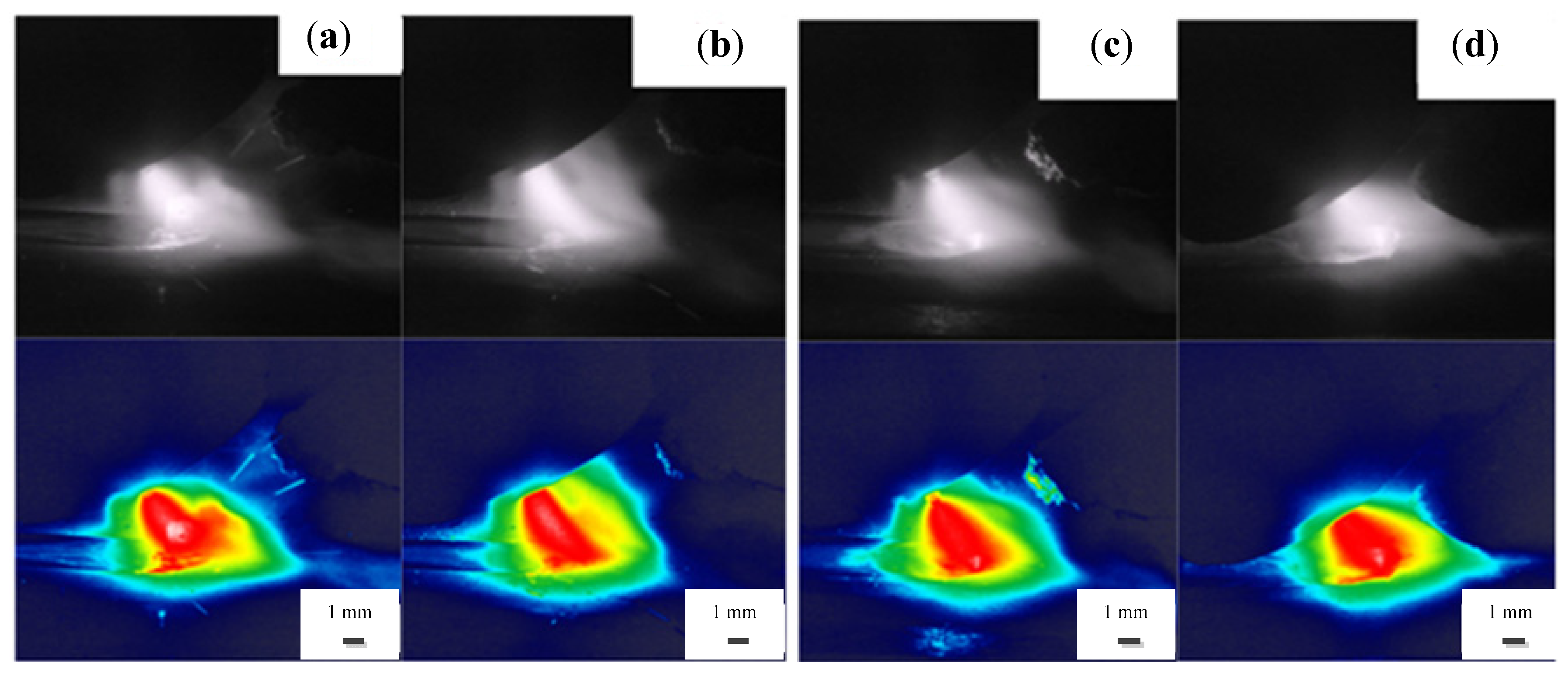





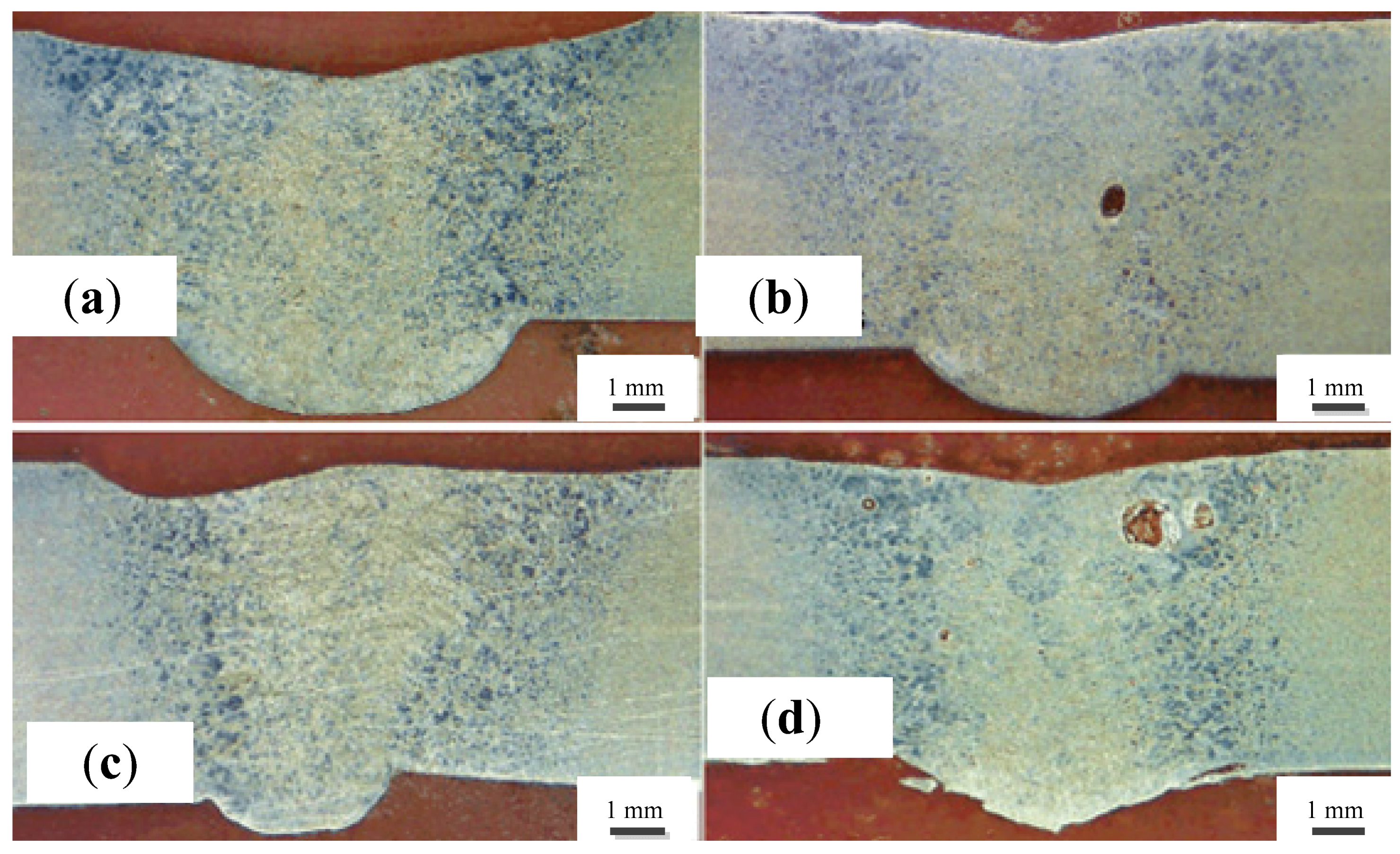

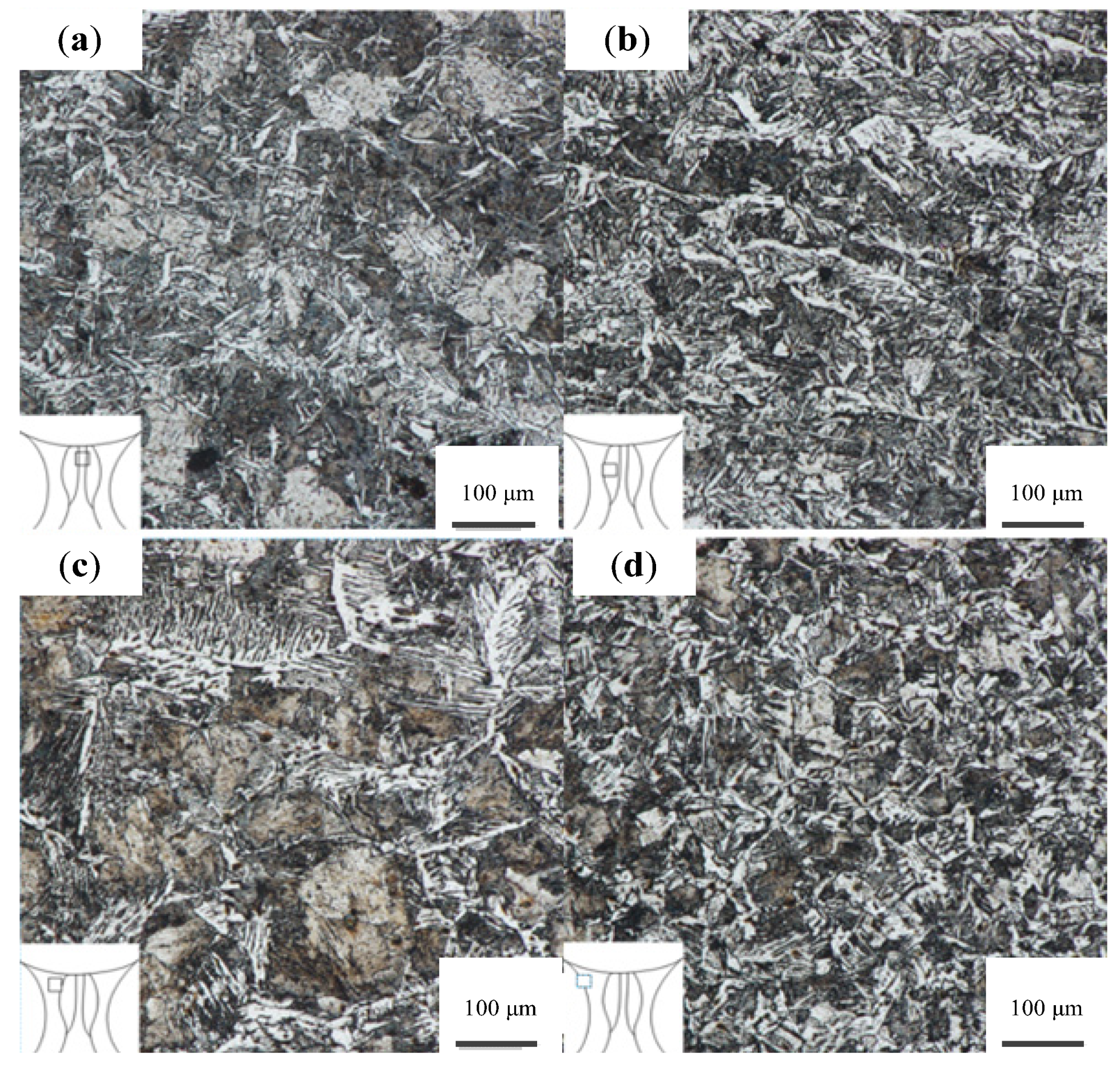

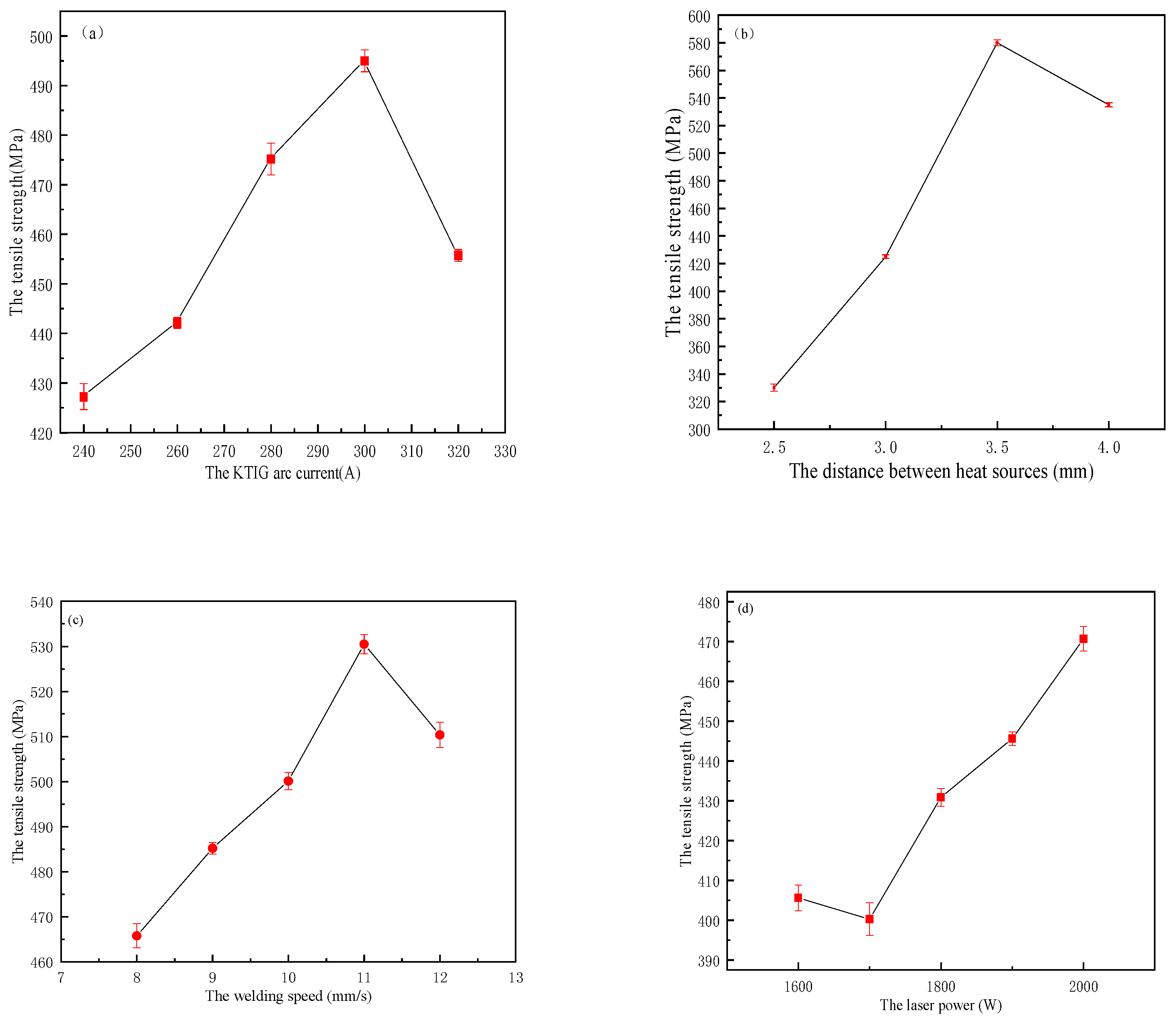
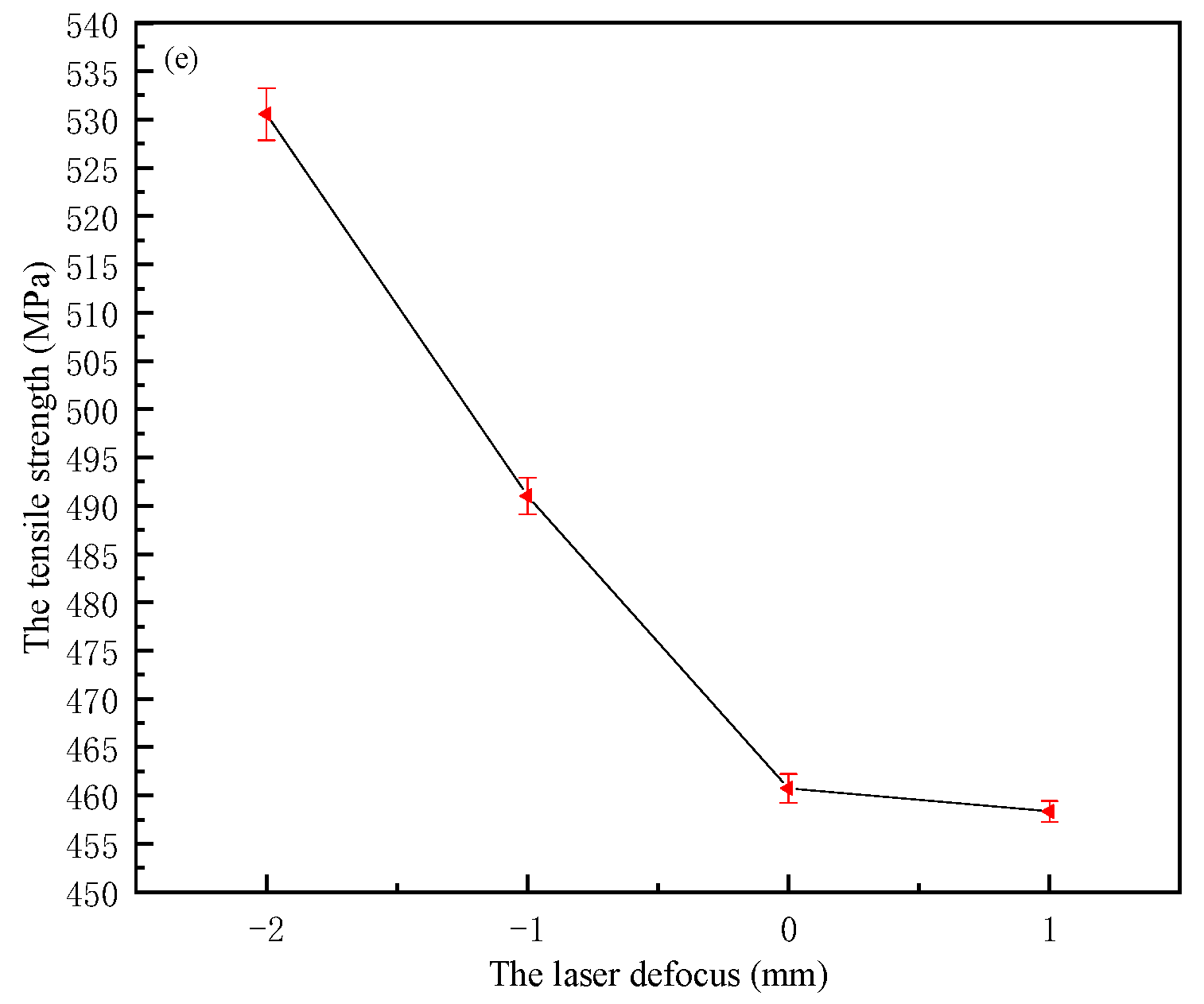
| Material Name | Quality Level | C | Mn | Si | S | P |
|---|---|---|---|---|---|---|
| Q235 | B | <0.22 | 0.3–0.65 | <0.35 | <0.050 | <0.045 |
| Material Name | Yield Strength/MPa | Tensile Strength/MPa | Elongation % | Impact Energy Akv/J |
|---|---|---|---|---|
| Q235 | 235 | 370–500 | ≥20 | ≥29 |
| Parameter Set | K-TIG Current/A | Laser Power/W | Defocus Amount/mm | Heat Source Spacing/mm | Welding Speed/mm/s |
|---|---|---|---|---|---|
| #1 | 220, 260, 300, 340 | 1800 | −2 | 4.5 | 9 |
| #2 | 260, 280, 300, 320 | 1800 | −2 | 4.5 | 9 |
| #3 | 220 | 1800 | −2 | 2.5, 3.5, 4.5 | 9 |
| #4 | 220 | 1600, 1700, 1800, 1900 | −2 | 4.5 | 9 |
| #5 | 220 | 1800 | −2, 0, 2 | 4.5 | 9 |
| #6 | 220 | 1800 | −2 | 4.5 | 8, 9, 10, 11 |
| #7 | 320 | 1700 | −2 | 4 | 11 |
Publisher’s Note: MDPI stays neutral with regard to jurisdictional claims in published maps and institutional affiliations. |
© 2022 by the authors. Licensee MDPI, Basel, Switzerland. This article is an open access article distributed under the terms and conditions of the Creative Commons Attribution (CC BY) license (https://creativecommons.org/licenses/by/4.0/).
Share and Cite
Zhang, H.; Yu, J.; Zhang, Z.; Gao, J.; Su, Z.; Sun, Z.; Li, Y. Arc Characteristics and Welding Process of Laser K-TIG Hybrid Welding. Metals 2022, 12, 1139. https://doi.org/10.3390/met12071139
Zhang H, Yu J, Zhang Z, Gao J, Su Z, Sun Z, Li Y. Arc Characteristics and Welding Process of Laser K-TIG Hybrid Welding. Metals. 2022; 12(7):1139. https://doi.org/10.3390/met12071139
Chicago/Turabian StyleZhang, Hongchang, Jiang Yu, Zixiao Zhang, Jianguo Gao, Zhaofang Su, Zhaorong Sun, and Yinan Li. 2022. "Arc Characteristics and Welding Process of Laser K-TIG Hybrid Welding" Metals 12, no. 7: 1139. https://doi.org/10.3390/met12071139
APA StyleZhang, H., Yu, J., Zhang, Z., Gao, J., Su, Z., Sun, Z., & Li, Y. (2022). Arc Characteristics and Welding Process of Laser K-TIG Hybrid Welding. Metals, 12(7), 1139. https://doi.org/10.3390/met12071139







